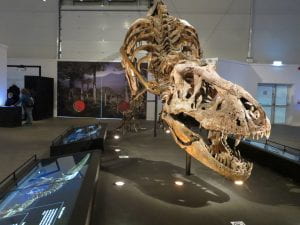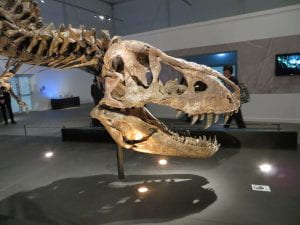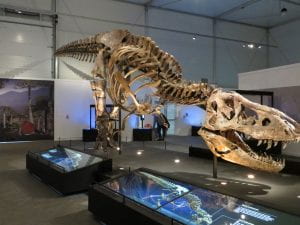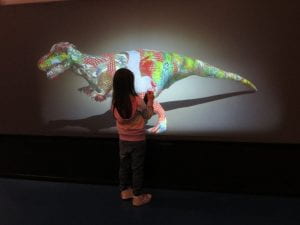 In the summer of 2019, the city of Glasgow was home to a spectacular dinosaur. “T. REX in Town” was an exhibition of a fully mounted T. rex skeleton, on tour around Europe, with Glasgow the only stop in the UK.
In the summer of 2019, the city of Glasgow was home to a spectacular dinosaur. “T. REX in Town” was an exhibition of a fully mounted T. rex skeleton, on tour around Europe, with Glasgow the only stop in the UK.
The centrepiece of the exhibition was ‘Trix: the Grand Old Lady’, a well preserved specimen that was excavated in Montana, in 2013, by the Naturalis Biodiversity Center, in Leiden, the Netherlands, and the Black Hills Institute in Hill City, South Dakota. The team was led by Anne Schulp from Leiden and Pete Larson from the Black Hills Institute. Early in the excavation, palaeontologists realised this was a large T. rex with a relatively complete skeleton, and while it was being prepared in the Black Hills Institute, several unusual features were found that made it a special and important fossil.
The T. rex was identified as a female because the skull had thick protuberances over the eyes which is thought to be typical of the female and continued to grow throughout life. The protuberances on this skull were very developed which also implied she had lived to a ripe old age. She was an old lady.
Another unusual feature was the number of injuries on the skeleton, including broken ribs and a line of five holes in the jaw that were inflicted by another T. rex, as well as an injury to the tail and clear evidence of scars on the fossilised bone caused by infection, scars that showed some evidence of healing so the injuries and infections were suffered during her life.
And the name? Initially referred to as ‘Grandma Rex’, the specimen was eventually named ‘Trix’ after Beatrix, the former queen of the Netherlands, and given the additional label of ‘Grand Old Lady’ as a reference to her size and age. Her lifespan could be estimated by counting the growth lines in the bones, rather like growth rings in a tree can give its age, and the researchers think that Trix was around thirty when she died.
The exhibition was held in a large hall with the specimen as the centre piece and various panels surrounding her pointing out the features and injuries on the skeleton.
Several additional, generally interactive side exhibits showed features of the dinosaur such as an animated hologram of a T. rex hatching from an egg, interactive screen/movement centres allow visitors – particularly energetic children – to find out if they could outrun a T. rex or make a T. rex move.
A fun exhibit allowed visitors to “spray paint” a T. rex with different colours and patterns and two videos showed details of the excavation and the scientists preparing the specimen.
There was an addition to the exhibition in Scotland, including a dinosaur footprint from Skye with explanatory material from the Staffin Museum, on Skye, about Scotland’s own dinosaurs.
I visited in early July and certainly felt the a sense of awe in standing next to such a magnificent dinosaur. She was mounted as if lunging forward, so the skull was at eye-level and the signs clearly explained where the injuries were. Mounted in the centre of the hall meant she could be viewed from all angles and the additional exhibits around the side meant visitors had plenty of room.
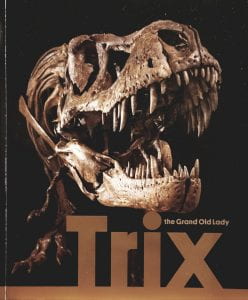 The exhibit had its own shop and café, and the shop sold a range of merchandise from children’s toys and books to local themed merchandise such as bags, t-shirts etc, but didn’t have much in the way of adult books on dinosaurs. It did, however, sell a sumptuous exhibition guide book, with background material on the dig, the people involved and the science used; my only frustration with the guide book was the printing of large, dramatic images across two pages yet the binding meant that the centre spine ran down the centre of the image.
The exhibit had its own shop and café, and the shop sold a range of merchandise from children’s toys and books to local themed merchandise such as bags, t-shirts etc, but didn’t have much in the way of adult books on dinosaurs. It did, however, sell a sumptuous exhibition guide book, with background material on the dig, the people involved and the science used; my only frustration with the guide book was the printing of large, dramatic images across two pages yet the binding meant that the centre spine ran down the centre of the image.
If you still want to see Trix, her European tour is now finished and she has gone back to Leiden, but will be on permanent display at the Naturalis Biodiversity Center in a new purpose built museum, opening later in 2019.
Reference:
- ‘Trix:The Grand Old Lady’, Marijke Besselink, published by Naturalis Biodiversity Center, Leiden, 2016.


